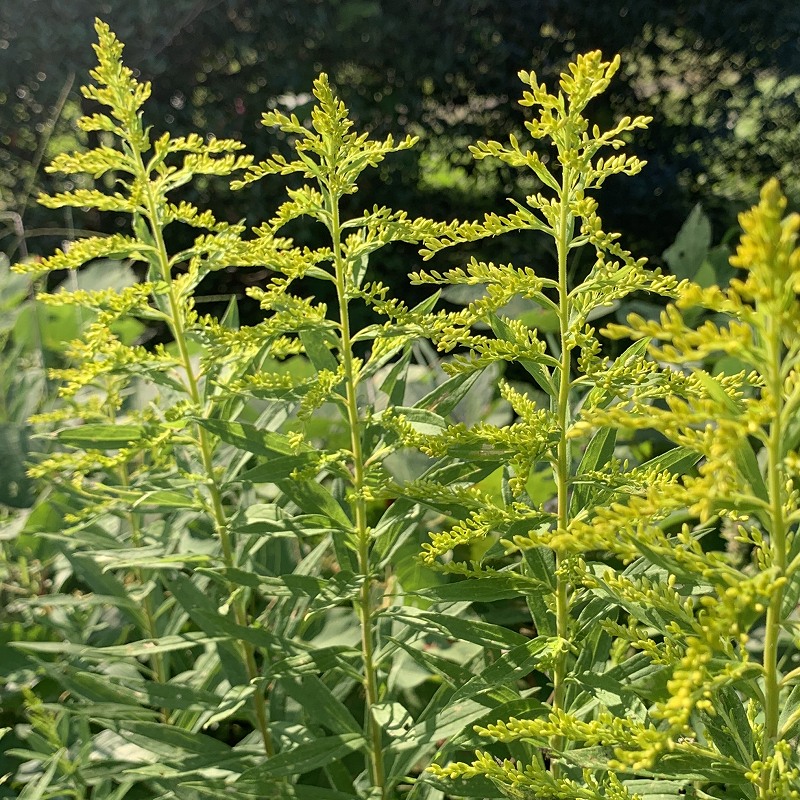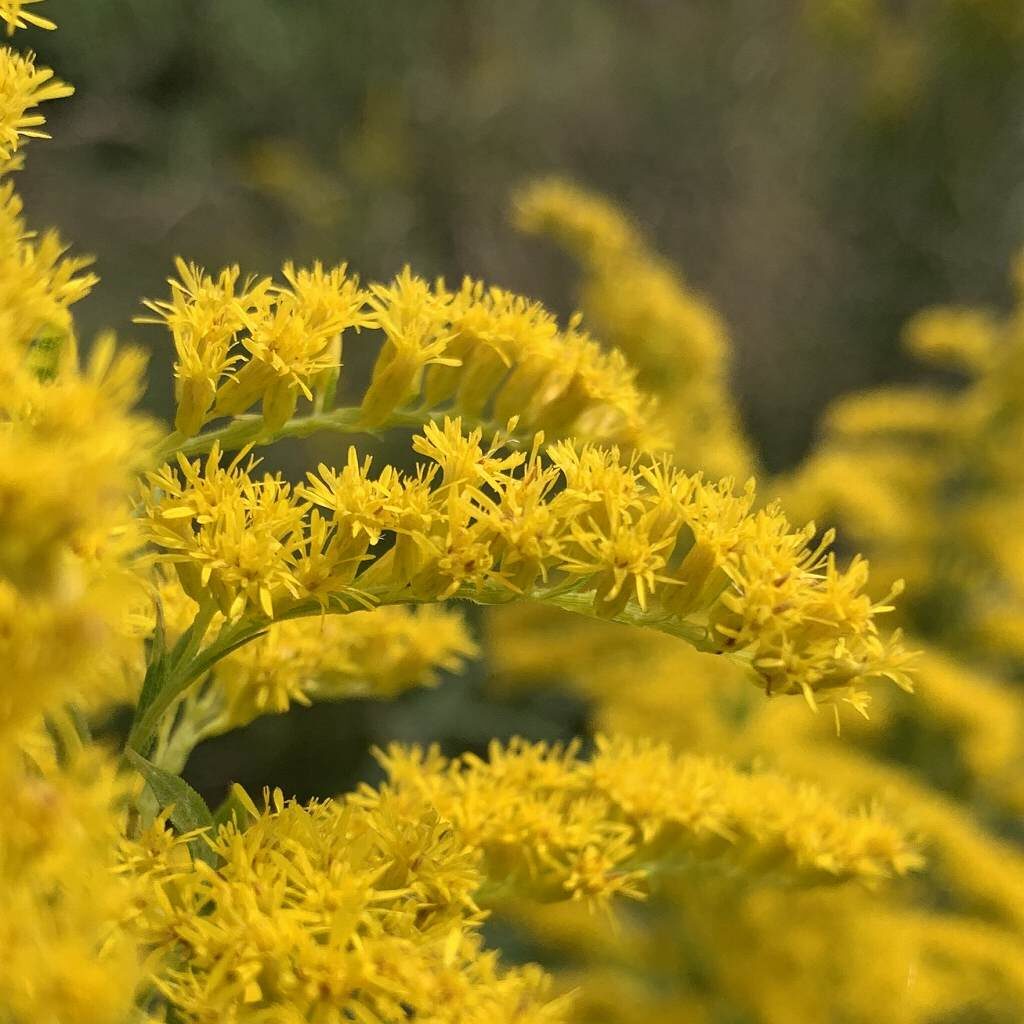セイタカアワダチソウの名前の由来は近縁の泡立草に似ていて、お酒を醸すときの泡立ちのように、小さな花々が弾けるように咲くからです。
The Japanese name of Golden Rod means frothy grass. The small flowers burst into bloom, like bubbles when brewing sake.
【仮名】セイタカアワダチソウ
【和名】背高泡立草
【英名】Golden Rod
【学名】Solidago altissima
【誕生】10/ 01, 11/ 02
【開花】10, 11月
【花色】Yellow




セイタカアワダチソウ
セイタカアワダチソウの来歴
セイタカアワダチソウはキク科の多年草。原産地は北米大陸中北部で、現地での英名ゴールデンロッドは「金の鞭」という意味です。日本へは明治時代に観賞用で移入され、第二次世界大戦後の輸入物資に紛れていた種子から本格的に拡大。日当たりの良い野原などで群生しています。
セイタカアワダチソウの名前
セイタカアワダチソウの名前の由来は、姿形が近縁の「泡立草」に似ているから。お酒を醸すときの泡立ちのように、小さな花々が弾けるように咲きます。ラテン語の種名アルテシーマは「とても丈が高い」という意味。茎葉がサポニンを含んでいるため、湯舟に入れると泡立ちます。
セイタカアワダチソウの姿形
セイタカアワダチソウの草丈は通常2m前後、肥沃地では4m前後。葉は被針形で互生し、全体的に短毛が密生します。花は筒状の両性花が5つくらい、その周りに舌状の雌性花が10枚くらい。花穂の主軸と横枝に密集して咲きます。花後は蒴果を結び、冠毛のついた種子が風で飛散。
セイタカアワダチソウの近縁
セイタカアワダチソウの近縁「大泡立草」も原産地が北米の外来種です。開花時期が7~9月と早く、草丈が半分くらいで、全体的にほぼ無毛。「秋の麒麟草」は草丈がさらに小さく、「泡立草」とも呼ばれます。背高泡立草よりも先に広がりましたが、背高泡立草に席巻されて衰退。
セイタカアワダチソウの盛衰
セイタカアワダチソウは周囲の植物の成長を抑制する物質を根茎から分泌し、薄などの在来植物を圧倒する「他感作用」があります。しかし、その物質が皮肉にも自らの成長を抑制。さらに、アワダチソウグンバイによる食害なども加わって勢力が衰え、在来植物が盛り返しています。
セイタカアワダチソウの利用
セイタカアワダチソウは花蜜と花粉が多く、養蜂家にとっては冬に備える貴重な蜜源植物。その蜂蜜には麝香臭があり、日本では好まれないものの、北米では人気があります。茎葉は茹でても青臭く、食用には不向き。ただし、栄養価が高いので、牛の放牧草として注目されています。
Golden Rod
Golden Rod is a perennial plant of the Asteraceae family. The place of origin is the central and northern part of the North American continent, and the local English name means “golden whip”. It was introduced to Japan for ornamental purposes in the Meiji period, and after the Second World War, seeds mixed with imported goods proliferated and spread throughout the country. It grows in colonies in sunny fields.
The Japanese name of Golden Rod means frothy grass. The small flowers burst into bloom, like bubbles when brewing sake. The Latin species name Altissima means “very tall”. It foams when put in a bathtub because the stems and leaves contain saponin.
The plant height of Golden Rod is usually around 2 meters, and around 4 meters in fertile land. The leaves are needle-shaped and alternate, and the short hairs grow densely throughout. The flowers are about 5 tubular neutral flowers, surrounded by about 10 tongue-shaped female flowers. It blooms densely on the main axis and lateral branches of the spike. After flowering, it forms a capsule, and the pappus-bearing seeds are scattered by the wind.
“Solidago gigantea”, which is closely related to Golden Rod, is also native to North America. Flowering time is early from July to September, plant height is about half, and hairless overall. “Solidago virgaurea” is even shorter. It spread earlier than Golden Rod, but it was swept away by Golden Rod and declined.
Golden Rod secretes a substance from its rhizome that suppresses the growth of surrounding plants, and has an “Allelopathy” that overwhelms native plants such as pampas grasses. However, the substance ironically suppresses its own growth. In addition, due to feeding damage by Corythucha marmorata, the power has declined, and the native plants are making a comeback.
Golden Rod has a large amount of nectar and pollen, making it a valuable source of nectar for beekeepers in winter. The honey has a musky odor, which makes it unpopular in Japan but popular in North America. Stems and leaves have a grassy smell even when boiled, and are not suitable for eating. However, due to its high nutritional value, it is attracting attention as a pasture grass for cattle.


